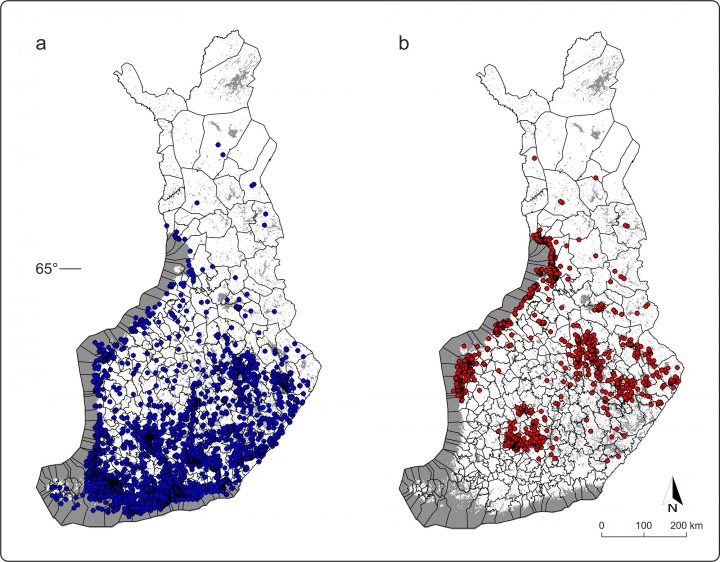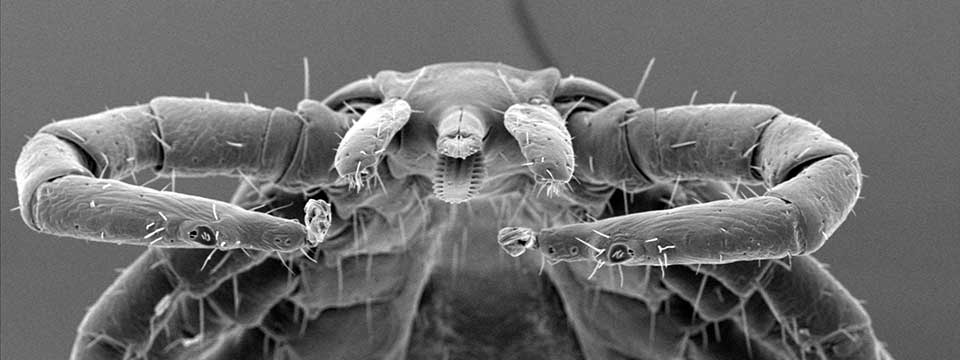Fästingar och fästingburna sjukdomar i Finland
Fästingar i släktet Ixodes har förökat sig kraftigt i Finland och resten av Europa. Det beror troligtvis på klimatförändringarna, som gynnar fästingar och/eller deras värdar.
I Finland förekommer det två fästingsarter, som är skadliga för människan: vanlig fästing (Ixodes ricinus) och taigafästing (Ixodes persulcatus). Med blotta ögat är det svårt att se skillnad mellan den vanliga fästingen och taigafästingen och de kan förekomma i samma områden. Båda arterna har dessutom samma värdar: vilda däggdjur, sällskapsdjur, husdjur och människan.
Fästingar bär på allvarliga smittor varav de främsta är borrelios, som orsakas av en bakterie, och fästingburen hjärninflammation (TBE, Kumlingesjuka), som orsakas av ett virus. Det finns ett vaccin mot TBE, medan bakterieinfektioner vårdas med antibiotika.
Vår forskargrupp vid Åbo Universitet undersöker förekomsten av den vanliga fästingen och taigafästingen i hela Finland. Vi studerar också förekomsten av olika smittämnen i insamlade prover genom molekylärbiologiska metoder.
Se hur forskare samlar in fästingar.

Utbredning av (a) vanlig fästing (I. ricinus) och (b) taigafästing (I. persulcatus) i Finland, baserad på insamling gjord av allmänheten (Laaksonen et al. 2017, 2018).
Vetenskapliga publikationer
- Alale, T.Y. et al. 2025: Tick-borne viruses in Finland: Public health risks, interventions and research insights. – Veterinary Medicine and Science 11: e70638.
- Lamppu, M. et al. 2025: Repeated cross-sectional surveys show a decreasing trend in Borrelia burgdorferi sensu lato seroprevalence over a 50-year period, Finland, 1966 to 2017. – Eurosurveillance 30: 2500171.
- Tanski, N. et al. 2025: Ghosts of weather past? Impact of past and present weather-related factors on the seasonal questing activity of Ixodes ricinus nymphs in southwestern Finland. – Parasites & Vectors 18, 283.
- Sormunen, J.J. et al. 2025: Ticks and tick-borne pathogens encountered by dogs and cats: a North European perspective. – Transboundary and Emerging Diseases 2025: 5574554.
- Sormunen, J.J. et al. 2025: There goes the neighbourhood— a multi-city study reveals ticks and tick-borne pathogens commonly occupy urban green spaces. – Zoonoses Public Health .72: 313–323.
- Alale, T.Y., et al. 2024: Public knowledge and awareness of tick-borne pathogens and diseases: A cross-sectional study in Ghana. – Current Research in Parasitology & Vector-Borne Diseases 6: 100228.
- Alale, T.Y. et al. 2024: Genomic signatures of hybridization between Ixodes ricinus and Ixodes persulcatus in natural populations. – Ecology and Evolution 14: e11415.
- Sormunen, J.J. et al. 2024: Blood meal analysis reveals sources of tick-borne pathogens and differences in host utilization of juvenile Ixodes ricinus across urban and sylvatic habitats. – Zoonoses and Public Health 71: 442–450.
- Sormunen, J.J. et al. 2023: Crowdsourced tick observation data from across 60 years reveals major increases and northwards shifts in tick contact areas in Finland. – Scientific Reports 13: 21274.
- Sormunen, J.J. et al. 2023: For the people by the people: Citizen science web interface for real-time monitoring of tick risk areas in Finland. – Ecological Solutions and Evidence 4: e12294.
- Sormunen, J.J. et al. 2023: Voles, shrews and red squirrels as sources of tick blood meals and tick-borne pathogens on an island in southwestern Finland. – Ticks and Tick-borne Diseases 14: 102134.
- Kulha, N. et al. 2022: Does environmental adaptation or dispersal history explain the geographical distribution of Ixodes ricinus and Ixodes persulcatus ticks in Finland? – Ecology and Evolution 12: e9538.
- Sormunen, J.J. et al. 2022: Ticks (Acari: Ixodidae) parasitizing migrating and local breeding birds in Finland. – Experimental and Applied Acarology 86: 145–156.
- Sormunen, J.J. et al. 2021: Absence of Francisella tularensis in Finnish Ixodes ricinus and Ixodes persulcatus ticks. – Ticks and Tick-borne Diseases 12: 101809.
- Sormunen, J.J. et al. 2020: Enhanced threat of tick-borne infections within cities? Assessing public health risks due to ticks in urban green spaces in Helsinki, Finland. – Zoonoses and Public Health 67: 822–838.
- Nyrhilä, S. et al. 2020: One out of ten: low sampling efficiency of cloth dragging challenges abundance estimates of questing ticks. – Experimental and Applied Acarology 82: 571–585.
- Sormunen, J.J. et al. 2020: Monitoring of ticks and tick-borne pathogens through a nationwide research station network in Finland. – Ticks and Tick-borne Diseases 11: 101449.
- Sormunen, J.J. et al. 2019: First evidence of Ixodiphagus hookeri (Hymenoptera: Encyrtidae) parasitization in Finnish castor bean ticks (Ixodes ricinus). – Experimental and Applied Acarology 79: 395–404.
- Klemola, T. et al. 2019: High tick abundance and diversity of tick-borne pathogens in a Finnish city. – Urban Ecosystems 22: 817–826.
- Sormunen, J.J. (doktorsavhandling) 2018: Questing ticks, hidden causes: tracking changes in Ixodes ricinus populations and associated pathogens in southwestern Finland. Annales Universitatis Turkuensis A II 349
- Sormunen, J.J. et al. 2018: The importance of study duration and spatial scale in pathogen detection – evidence from a tick-infested island. –Emerging Microbes & Infections 7: 189.
- Laaksonen, M. et al. 2018: Tick-borne pathogens in Finland: comparison of Ixodes ricinus and I. persulcatus in sympatric and parapatric areas. – Parasites & Vectors 11: 556.
- Laaksonen, M. et al. 2017: Crowdsourcing-based nationwide tick collection reveals the distribution of Ixodes ricinus and I. persulcatus and associated pathogens in Finland. – Emerging Microbes & Infections 6: e31.
- Sormunen, J.J. et al. 2016: Anaplasma phagocytophilum in questing Ixodes ricinus ticks in southwestern Finland. – Experimental and Applied Acarology 70: 491–500.
- Sormunen, J.J. et al. 2016. Tick-borne bacterial pathogens in southwestern Finland. – Parasites & Vectors 9: 168.
- Sormunen, J.J. et al. 2016. Assessing the abundance, seasonal questing activity, and Borrelia and tick-borne encephalitis virus (TBEV) prevalence of Ixodes ricinus ticks in a Lyme borreliosis endemic area in Southwest Finland. – Ticks and Tick-borne Diseases 7: 208–215.
- Mäkinen, J. et al. 2003. Prevalence of granulocytic Ehrlichia and Borrelia burgdorferi sensu lato in Ixodes ricinus ticks collected from Southwestern Finland and from Vormsi Island in Estonia. – Acta Pathologica, Microbiologica et Immunologica Scandinavica 111: 355–362.
Vi tackar för stödet
- Jane och Aatos Erkkos stiftelse
- Biologian laitos, Turun yliopisto
- Saaristomeren tutkimuslaitos, Turun yliopisto
- Turun Yliopistosäätiö
- Metsähallituksen luontopalvelut
- Turun kaupunki
- Suomen Kulttuurirahaston Varsinais-Suomen Maakuntarahasto
- Jenny ja Antti Wihurin Rahasto
- Lääkintöneuvos Sakari Alhopuro
- Lääketieteellinen tiedekunta, Turun yliopisto
- Pfizer Oy
- Nagu Rotaryklubb
Ta kontakt
puutiaiset@utu.fi
